
We kindly inform you that, as long as the subject affiliation of our 300.000+ articles is in progress, you might get unsufficient or no results on your third level or second level search. In this case, please broaden your search criteria.



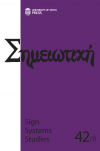
The problem of the “shift” in Lotmanian thought in his last period (the so-called Lotmanian explosion) still remains a subject of controversy for those who are interested in the scholarly heritage of Lotman. Besides explanations pointing out the “circumstantial” factors (for example, the historical context or influence from other thinkers) which brought about changes in Lotman’s views, it is important to identify a dimension of substantial “internal” changes which took place in the theoretical system itself. Regarding the essential changes relating to the concept of explosion as a movement from a ‘spatial’, more specifically ‘centre-periphery’ model to a ‘temporal’, namely ‘dislocated time’ model, the present article will focus on revealing the theoretical implication of this movement. The concept of explosion as an exceptional moment of ‘time out of joint’ was an active alternative to a theoretical breakthrough which was introduced in the process of overcoming the limitations of a previous ‘spatial’ model.
More...
Taking the example of two 1960s popular spy films this paper explores how social semiotics can make a contribution to the analysis of film music. Following other scholars who have sought to create inventories of sound meanings to help us break down the way that music communicates, this paper explores how we can draw on the principles of Hallidayan functional grammar to present an inventory of meaning potentials in sound. This provides one useful way to describe the semiotic resources available to composers to allow them to communicate quite specific ideas, attitudes and identities through combinations of different sounds and sound qualities, by presenting them as systems of meaning rather than as lists of connotations. Here we apply this to the different uses of music and sound in Dr No and The Ipcress Files which allows us to show how we can reveal different ideologies of spying.
More...

In 1991, a book version of the doctoral dissertation written by Władysław Panas (1947–2005), a Polish literary scholar, appeared under the imprint of a university publishing house from Lublin – a big city in Eastern Poland. Its title in its entirety – In the circle of the semiotic method – stayed within the stream of research proposed by Juri Lotman and his associates. Due to objective circumstances, however, the publication’s reception did not measure up to its significance, and except for the recognition from specialists interested in the subject raised in the book, a further, detailed discussion of the theses presented therein remained missing. It happened so for a number of reasons. First of all, even at the time of it being published, Panas’ book was slightly belated.
More...
The aim of this paper is to outline a methodological framework for brand equity planning with structuralist rhetorical semiotics. By drawing on the connectionist conceptual model of the brand generative trajectory of signification it will be displayed in a stepwise fashion how a set of nuclear semes and classemes or an intended semic structure that underlies manifest discursive structures may be projected by its internal stakeholders (i.e., a brand management team, an account planning team or a marketing research team) with view to attaining differential brand associations. The suggested methodological framework focuses on the strength and uniqueness of brand associations as integral aspects of a brand’s equity structure and comprises a set of calculi that aim at addressing from a brand textuality point of view how associations may be systematically linked to their key sources with an emphasis on the ad filmic text. The propounded methodology is exemplified by recourse to a corpus of ad filmic texts from the major brand players in the UK cereals market. The argumentative thrust is intent on demonstrating that structuralist rhetorical semiotics is not only useful for analysing/interpreting brand texts, but, moreover, for constructing and for managing them over time. This demonstration is deployed by adopting a synchronic/diachronic and intra-(ad)-filmic/inter-(ad)-filmic approach to the formation of brand associations that make up a projected brand equity structure, in the context of embedded product category dynamics.
More...


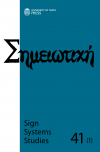
Th e paper provides an empirical study of semiotic mechanisms of culture. We apply the methodology developed by the Tartu-Moscow School of Semiotics, building also on the criteria of boundary-work dynamics to examine a collected corpus of adverts appearing in Silesian Catholic periodicals (in German and in Polish) from the second half of the 19th and early 20th centuries. We discuss the cultural implications of the diff erences and similarities in German and Polish ads and propose functional explanations of the results in terms of the notion of boundary confi gurations in a region as a particular structuring of cultural codes. Th e two analytical axes are the social boundary implicated in the use of German vs. Polish on the parameter of ‘sacred’ (sacrum) reference, and the symbolic border in the use of Fraktur (German script) versus Antiqua (Latin script) (boundary objects).
More...
Jean Baudrillard, the scholar and critic of postmodernity, struggled with questions of postmodern ontology: representation of the real through the semiotic process of signifi cation is threatened with the rise of simulacra, the simulated real.With this rise, seductive semiotic relationships between signs replace any traditional ontological representamen. Th is struggle has implications for environmentalism since the problems of contemporary environmental philosophy are rooted in problems with ontology. Hence the question of postmodern ecology: can the natural survive postmodern simulation? Baudrillard’s communicative analysis of semiotic postmodernity can both support and extend ecosemiotic theses in response to these questions, questions that must be answered in order to explore our paradoxical understandings of the natural and confi rm an understanding of environmentalism for postmodernity. In this paper I will argue for the merit of a semiotic understanding of postmodernity, develop the idea of ecology in this context, and then compare Baudrillard’s approach to the contemporary development of ecosemiotics.
More...
For all his profound interest in Secondness and its manifestation in various kinds of indices, including deictics, Peirce rarely addresses the inter-pronominal relationships. Whilst the American founder of semiotics would designate language as a whole to Th irdness, only within the larger framework of which deictics can work, the German philosopher Cassirer observes that “what characterizes the very fi rst spatial terms that we fi nd in language is their embracing of a defi nite ‘deictic’ function”. For Cassirer the signifi cance of pronominals, especially the I-Th ou relationship, lies in its impact on the development of spatial concept that lays the foundation of symbolic forms. It may look strange why the “designatives” of I, Th ou, He, in Peirce’s own terms, so obvious in their categorial and empirical differentiation, should fail to be reduceable to the triad of Firstness, Secondness, and Th irdness. It is interesting, however, that in his 1906 correspondence with Lady Welby, Peirce should refer to the strange “Communicational Interpretant”, or “the Cominterpretant, which is a determination of that mind into which the minds of utterer and interpreter have to be fused in order that any communication should take place”. Peirce asserts that this communication of a Form, say, being in love, is made possible by sign. Th is paper discusses Peirce’s and Cassirer’s references to deictics or indexical sign, in particular, inter-personal relationships, in light of Benveniste’s concept of discourse, and probes into a possible subtext underlying the Peirce- Welby correspondence.
More...
Hereby we provide a list of all semiotic journals currently published in the world, which includes 53 titles. From among these, 42 are printed on paper (among them six international journals on general semiotics, 16 journals specializing in some branch of semiotics, and 20 regional semiotics journals), while 11 appear only as electronic publications. All in all, these journals publish articles in 16 languages.
More...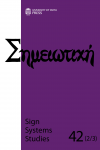
The paper discusses the theory of semiosis in the context of Peirce’s philosophy of evolution. Focussing on the thesis that symbols grow by incorporating indices and icons, it proposes answers to the following questions: What does Peirce mean by the “self-development of signs” in nature and culture and by symbols as living things? How do signs grow? Do all signs grow, or do only symbols grow? Does the growth of signs presuppose semiotic agency, and if so, who are the agents in semiosis when signs and sign systems grow? The paper discusses objections raised by culturalists and historical linguists against the assumption that signs can still grow and are still growing in complex cultures, and it draws parallels and points out differences between Peirce’s theory of semiotic growth and the theories of memetics and teleosemiotics.
More...
In the context of the relationship between signs and concepts, this paper tackles some of the ongoing controversies over conceptual development and change – including the claim by some that concepts are not open to revision at all –taking the position that concepts pull apart from language and that concepts can be discussed on at least four levels: that of individual agent, community, society, and language. More controversially, it claims that concepts are not just inherently open to revision but that they, and the frameworks of which they form part, are in a state of continuous, if generally incremental, change: a position that derives directly from the enactive tradition in philosophy. Concepts, to be effective as concepts, must strike a careful balance between being stable enough to apply across suitably many contexts and flexible enough to adapt to each new context. The paper’s contribution is a comparison and contrast of conceptual development and change on four time scales: that of the day-to-day life of an individual conceptual agent, the day-to-day life of society, the lifetime of an individual agent, and the lifetime of society and the human species itself. It concludes that the relationship between concepts and experience (individual or collective) is one of circular and not linear causality.
More...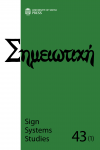
Spatial modelling concerns both the case when spatial structures have a modelling function and the case when such structures become modelled objects. In the article, spatial models are considered as the means of human activity in both external and internal aspects. External spatial models are tangible objects which have structural similarity with something different from them and can represent it for a subject. These external models can be interpreted on various mental levels: sensorial, perceptual, apperceptual and conceptual ones. Each of them is connected with a peculiar way of internal modelling. Both external and internal spatial models can have a productive or a reproductive character, which depends on whether they serve as patterns for reproduction or if they are copies of originals. It is possible to consider external models as spatial texts if they can be divided into a plane of expression and a plane of content which are connected with each other by a semiotic system. In particular, such division can be revealed in depictions in which the two planes of both depicting and depicted spaces are open for the eye and their connection is regulated by indexes of a special perceptographic code. So, depictions can be treated as spatial texts interpreted firstly on the perceptual level of internal modelling and, secondly, on the higher mental levels by means of other visual-spatial codes.
More...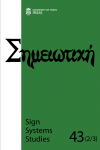
On the basis of the principle of non-premeditation of speech, we argue that the synchronicity of hearing shared by everybody present is incompatible with a division of time between a sender and a receiver of a message. Th e act of speech brings the participants together in a single moment of perception called a synchronous point. Both the act of speech and music do not appear through time; rather, speech and music create time. Th e present time of our casual experience always contains a part of radical novelty, probable a posteriori, yet never predicted. Despite our capacity to predict many things and repeat procedures, in the advent of a given moment, the present will always show its uniqueness. Th us, improvisation is based on two principles of uncertainty: the non-premeditated occurrence of speech and the non-predicted part of present time.
More...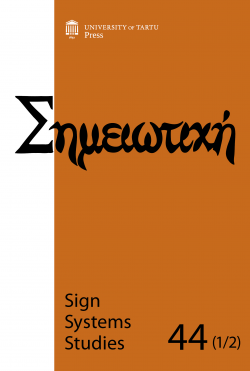
Ordinarily, a confession would not be a reply to a request or even a response to an invitation; a classic confession precipitates from an inner compulsion. This essay is a confession, even though it was nudged into existence by Kalevi Kull, the “who”, inviting me, the “whom”, to write some nebulous “what”. There was a suggestion of “when” (yet deadlines fortunately never die), and an assumption that I would grasp the “how” and that the “where” would be irrelevant.
More...